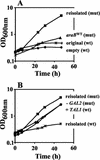A modified Saccharomyces cerevisiae strain that consumes L-Arabinose and produces ethanol
- PMID: 12839792
- PMCID: PMC165137
- DOI: 10.1128/AEM.69.7.4144-4150.2003
A modified Saccharomyces cerevisiae strain that consumes L-Arabinose and produces ethanol
Abstract
Metabolic engineering is a powerful method to improve, redirect, or generate new metabolic reactions or whole pathways in microorganisms. Here we describe the engineering of a Saccharomyces cerevisiae strain able to utilize the pentose sugar L-arabinose for growth and to ferment it to ethanol. Expanding the substrate fermentation range of S. cerevisiae to include pentoses is important for the utilization of this yeast in economically feasible biomass-to-ethanol fermentation processes. After overexpression of a bacterial L-arabinose utilization pathway consisting of Bacillus subtilis AraA and Escherichia coli AraB and AraD and simultaneous overexpression of the L-arabinose-transporting yeast galactose permease, we were able to select an L-arabinose-utilizing yeast strain by sequential transfer in L-arabinose media. Molecular analysis of this strain, including DNA microarrays, revealed that the crucial prerequisite for efficient utilization of L-arabinose is a lowered activity of L-ribulokinase. Moreover, high L-arabinose uptake rates and enhanced transaldolase activities favor utilization of L-arabinose. With a doubling time of about 7.9 h in a medium with L-arabinose as the sole carbon source, an ethanol production rate of 0.06 to 0.08 g of ethanol per g (dry weight). h(-1) under oxygen-limiting conditions, and high ethanol yields, this yeast strain should be useful for efficient fermentation of hexoses and pentoses in cellulosic biomass hydrolysates.
Figures




References
-
- Barnett, J. A. 1976. The utilization of sugars by yeasts. Adv. Carbohydr. Chem. Biochem. 32:125-234. - PubMed
-
- Boles, E., and F. K. Zimmermann. 1993. Saccharomyces cerevisiae phosphoglucose isomerase and fructose bisphosphate aldolase can be functionally replaced by the corresponding enzymes of Escherichia coli and Drosophila melanogaster. Curr. Genet. 23:187-191. - PubMed
-
- Brand, K. 1974. Transaldolase, p. 752-756. In H. U. Bergmeyer (ed.), Methoden der enzymatischen analyse 1. Verlag Chemie, Weinheim, Germany.
-
- Chiang, C., and S. G. Knight. 1961. l-Arabinose metabolism by cell free extracts of Penicillium chrysogenum. Biochim. Biophys. Acta 46:271-278. - PubMed
Publication types
MeSH terms
Substances
LinkOut - more resources
Full Text Sources
Other Literature Sources
Molecular Biology Databases

